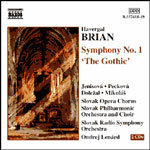
Brian: Symphony No. 1, The Gothic
 $35.00
Out of Stock
$35.00
Out of Stock6+ weeks add to cart
HAVERGAL BRIAN
Brian: Symphony No. 1, The Gothic
Vladimir Dolezal (tenor) / Eva Jenisova (soprano) / Peter Mikulas (bass) / Dagmar Peckova (alto) / Slovak National Opera / Lenard
[ Naxos / 2 CD ]
Release Date: Saturday 12 June 2004
This item is currently out of stock. It may take 6 or more weeks to obtain from when you place your order as this is a specialist product.
"Now it's reissued at bargain price, no one who claims the slightest interest in 20th-century British music has any further excuse to be without this thrilling, astonishing work."
Calum MacDonald, BBC Music Magazine, 08/04
The life and works of Havergal Brian constitute the strangest phenomenon in twentieth-century British music. A contemporary of Vaughan Williams and Holst, he was born in 1876, to working-class parents, in the Staffordshire Potteries: the kind of background from which, in those days, major creative artists simply did not come. He left school at twelve and started work, for a coal mine, for timber firms, and as a carpenter's apprentice, but he had a good if haphazard musical education and, filled with an unquenchable desire to write music, he persisted against all odds throughout a very long and often hard life. He died at Shoreham-by-Sea, Sussex, in 1972 at the age of 96. For roughly eighty of those years he had been composing, one of the longest creative careers ever. He had known sudden success (in the 1900s), then personal crisis, social rejection, hard times, disappointment, and, for most of his last fifty years, obscurity. He was never absolutely forgotten, and his music won acclaim from, among others, Elgar, Tovey, and Richard Strauss, but he was commonly regarded as one of the generation that had had their chance, and failed to justify it, before World War I.
Since the 1950s there has been a spasmodic, but unmistakeable, growth of interest in Havergal Brian's music. His First Symphony, however, The Gothic, remains his most famous work, some might say his most notorious, on account of its length and the gigantic forces employed, which have earned an entry in the Guinness Book of Records under "Largest Symphony". Nevertheless it is in many ways his most personal and crucial work, the one that cost him most in the writing, the massive keystone of his copious creative œuvre. Before it came his songs and choral works, short orchestral pieces and the satirical opera The Tigers; after it came the long line of Symphonies Nos. 2 - 32, none of them on the same scale as The Gothic, but all affected by the experience of writing it.
Brian seems to have composed The Gothic at various times through a period of seven or eight years, and he was over fifty when he completed it. It unites two long-contemplated schemes, a work on Goethe's Faust and a setting of the Te Deum, in a symphonic vision of the Gothic Age (1150 - 1560) as a period of almost unlimited expansion of human knowledge, both secular and spiritual, both glorious and terrible. The first three movements, for large orchestra, form Part I, which relates in a general way to Goethe's Faust, Part 1 (Faust as the archetypal Gothic-Age man, seeker after hidden knowledge and aspiring mystic). In a sense, however, Part 1 is only a prelude. The fourth, fifth and sixth movements constitute Part II, twice the length of Part I, and here Brian's inspiration was the mighty Gothic cathedral and the music that was sung in it. Part II is a gigantic setting of the Te Deum for four soloists, two large double choruses, brass bands, and a much enlarged orchestra. The score's requirements, taken literally, of 32 woodwind, 24 brass, two timpanists, percussion needing seventeen players, celesta, two harps, organ, and an enlarged string section, outdo the most extreme demands of Mahler, Strauss or Schoenberg. In addition, two horns, two trumpets, two trombones, two tubas and one timpanist are specified for each of the four extra brass bands: a total of nearly 200 players. It attempts a new, freely evolving conception of structure while making use of the widest possible range of stylistic resources, spanning a great arch from neo-medieval vocal polyphony to shattering brass outbursts of purely twentieth-century barbarity. The work is also a tribute to all the music that Brian had known and loved, and all the people he cared about. 'This work', he wrote to his friend Granville Bantock on 27th June 1926, 'has been inside my heart for a lifetime and naturally there is inside it all those who have been very dear to me - who helped and moulded me'. On another occasion he spoke of the fifth movement as his personal memorial to Hans Richter, whose conducting of the Hallé Orchestra had been such an inspiration to Brian in his youth. The Gothic, then, is an acknowledgement of debts to the past, and a manifesto for the future, a massive reaffirmation of the idealism of the English musical renaissance, which had been so cruelly shaken by the 1914-18 War, to which its moments of violence and terror seem directly to relate. Three different levels of musical argument, dramatic, tonal, motivic, create the work's musical logic. On the expressive plane Part I is dynamic in the familiar symphonic sense, a demonstration of artistic continuity with the recent past, a logical development from the achievements of Wagner, Bruckner, Strauss, Elgar and early Schoenberg. Part II, however, is cultural drama, an evocation of the totality of Western Music around one great familiar unifying text. From the doubt whether the post-1918 world will respond to such heroic idealism stems the individual drama of the artist, who is heard still praying for the strength to continue in ever more personal tones as the Te Deum moves to its racked and agonized but not-quite-despairing conclusion.

